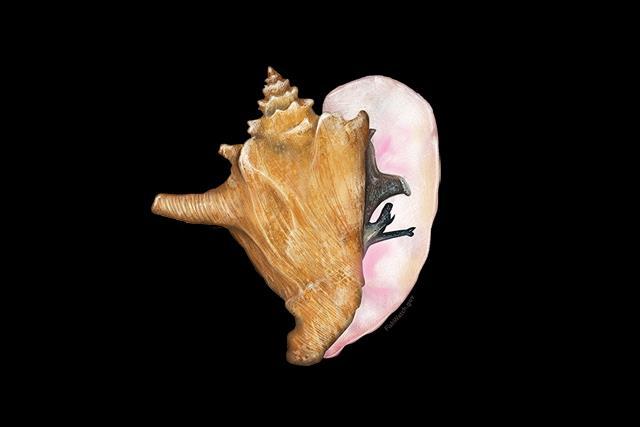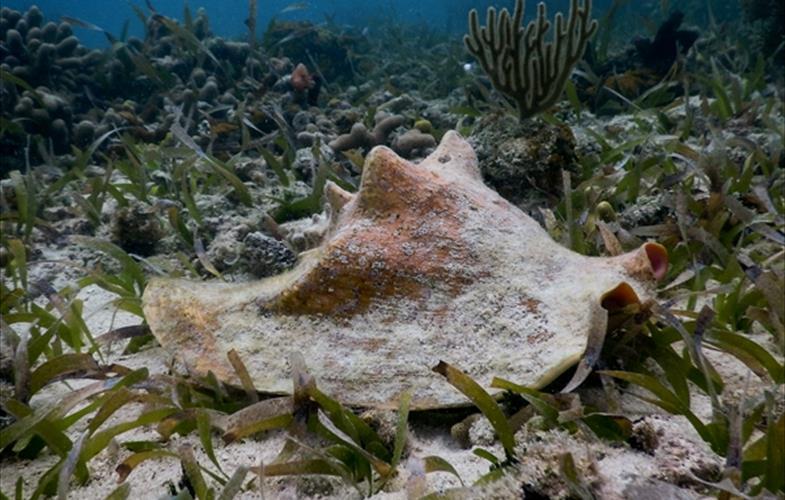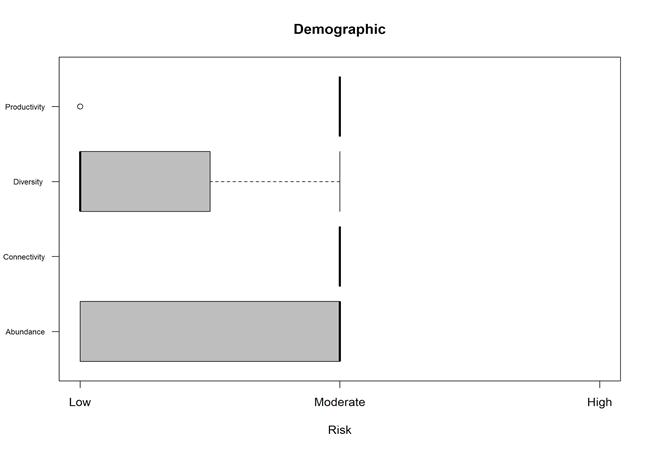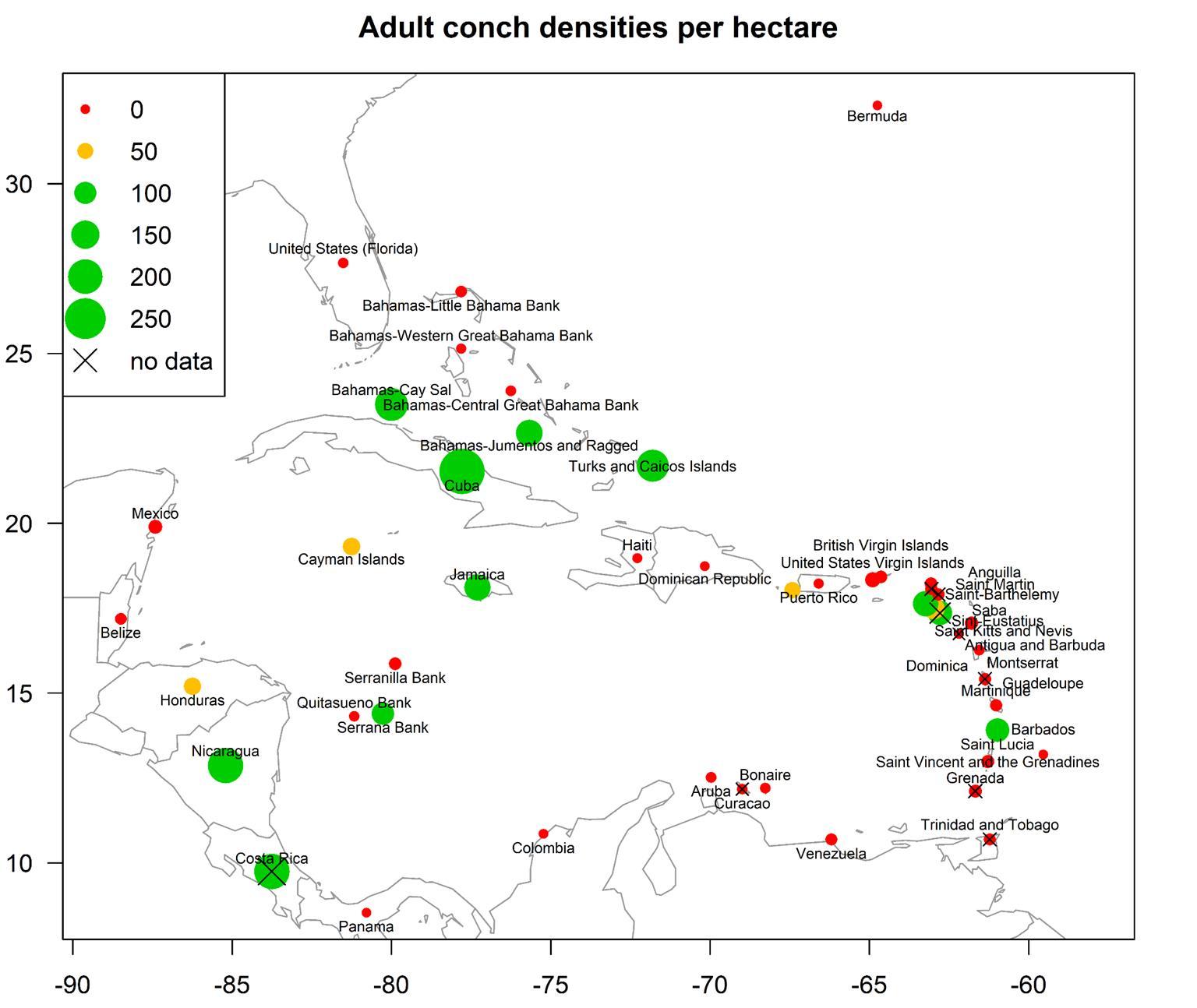
April 11, 2024

U.S. Department of Commerce | National Oceanic and Atmospheric Administration | National Marine Fisheries Service
SSC Meeting NOAA Fisheries - Southeast Regional Office Queen Conch ESA Final Listing
Key Messages
• On February 14th 2024, NOAA Fisheries published a final listing determination to list the queen conch (aliger gigas) as threatened under the Endangered Species Act (ESA).
• A threatened listing does not automatically assign protective regulations to the species, but protections are afforded under section 7 of the ESA.
• Federal agencies must ensure that activities they carry out, fund, or authorize are not likely to jeopardize the continued existence of the species
• Next steps will include the designation of critical habitat and the initiation of recovery planning
• Stakeholder engagement
• Protective regulations - under section 4(d)
• A threatened species does not automatically become an endangered species over time. A separate assessment would need to demonstrate that the species is presently at risk of extinction to warrant an endangered listing.

U.S. Department of Commerce | National Oceanic and Atmospheric Administration | National Marine Fisheries Service Page 2
How Do Species Become Protected Under the Endangered Species Act?
A species must be listed if it is threatened or endangered due to any of the following five factors:
A. Present or threatened destruction, modification, or curtailment of its habitat or range;
B. Overutilization for commercial, recreational, scientific, or educational purposes;
C. Disease or predation;
D. Inadequacy of existing regulatory mechanisms; and
E. Other natural or human-made factors affecting its continued existence.
The ESA requires that listing determinations be based solely on the best scientific and commercial information available; economic impacts cannot be considered in making species listing determinations.

U.S. Department of Commerce | National Oceanic and Atmospheric Administration | National Marine Fisheries Service Page 3
What is an Endangered or Threatened species?
Endangered: a species is considered “endangered” if it is in danger of extinction throughout all or a significant portion of its range.
● An “endangered species” is interpreted to be presently at risk of extinction.
● Endangered species are automatically protected by prohibitions of several types of "take" – including harming, harassing, collecting, or killing, under Section 9 of the ESA.
Threatened: defined as "any species which is likely to become an endangered species within the foreseeable future throughout all or a significant portion of its range."
● A “threatened species” is interpreted as a species that is not currently at risk of extinction but is likely to become so in the foreseeable future.
● Threatened species can receive protections through separate regulations issued under Section 4(d) of the ESA. These regulations occur separately from the listing. Also called 4(d) rules, they can include the same prohibitions under Section 9 of the ESA.
○ 4(d) rules allows us to customize prohibitions and regulate activities to provide for the conservation of threatened species.
A threatened designation does not automatically become an endangered listing over time. A further evaluation would need to demonstrate that the species is presently at risk of extinction to warrant an endangered listing.

U.S. Department of Commerce | National Oceanic and Atmospheric Administration | National Marine Fisheries Service Page 4
ESA Listing Process - Timelines
The following diagram shows the steps we take to evaluate a petition to list, delist, or reclassify a species.
● After receiving a petition, within 90 days (to the maximum extent practicable), we must publish a finding that states our decision whether or not to accept the petition.
● After we publish a positive 90-day finding, we begin a review of the species’ status (i.e., status review).
● Within one year, if, after conducting the review of the species’ status and considering ongoing conservation efforts, we determine the petitioned action…
○ Is not warranted and publish a negative 12-month finding
○ Is warranted, we publish a 12-month finding/Proposed Rule
● After publishing a proposed rule to list a species, we consider the public comments and any new data to make a final decision. We may also withdraw the proposed rule if we find there is not sufficient evidence to justify the proposed action.
● The final rule is generally published within one year of the proposed rule.
● After a final rule has been published, we begin recovery planning and critical habitat designations.


U.S. Department of Commerce | National Oceanic and Atmospheric Administration | National Marine Fisheries Service Page 5
Habitat Determination Recovery Planning
*
are here
Critical
*
You
Queen Conch ESA Background
● February 27, 2012: We received a petition from WildEarth Guardians to list the queen conch as threatened or endangered throughout all or a significant portion of their range under the ESA.
● August 27, 2012: NOAA Fisheries determined that the petitioned action may be warranted and published a positive 90-day finding in the Federal Register and opened a 60-day public comment period (77 FR 51763).
● November 5, 2014: NOAA Fisheries determined that listing queen conch as threatened or endangered under the ESA was not warranted and published the determination in the Federal Register (79 FR 65628).

● July 27, 2016: WildEarth Guardians and Friends of Animals (Plaintiffs) filed a lawsuit, in the U.S. District Court for the District of Columbia, challenging NOAA Fisheries decision not to list queen conch under the ESA.
● August 26, 2019: the Court vacated NOAA Fisheries determination that listing queen conch was not warranted and remanded the determination back to the NOAA Fisheries.
● December 06, 2019: NOAA Fisheries announced the initiation of a status review of queen conch to determine whether listing the species as endangered or threatened under the ESA was warranted. At that time we also opened a 60-day public comment period.
● December 2019 to May 2022: NOAA Fisheries assembled a status review team who conducted a comprehensive review of available information to develop a status review report.
● May 2022: NOAA Fisheries finalized the ESA Queen Conch Status Review Report.
● September 8, 2022: NOAA Fisheries published a proposed rule to list the queen conch as threatened under the ESA and opened a 60-day public comment period through November 7, 2022.
● November 10, 2022: NOAA Fisheries announced a public hearing and reopened the public comment period until Dec 15, 2022.
● February 14, 2024: NOAA Fisheries published a final rule to list the queen conch as threatened under the ESA.

U.S. Department of Commerce | National Oceanic and Atmospheric Administration | National Marine Fisheries Service Page 6
Endangered Species Act Status Review of the Queen Conch
Status Review Team: 7 Scientist and Policy Experts from NOAA Fisheries (Southeast Regional Office, West Coast Regional Office, Office of Protected Resources, Southeast Fisheries Science Center).
Status Review: This report summarizes the best available scientific and commercial information on the species and presents an evaluation of the queen conch’s status and extinction risk.
Published as NOAA Technical Memorandum.
● Considered information / data for approximately 39 jurisdictions throughout the Caribbean.
● Evaluated landings data from two international databases (FAO FishStat, Sea Around Us)
● Considered best available data on reproduction, depensatory processes, and reproductive density thresholds.
● Population connectivity model was developed to elucidate impacts from localized low adult densities on population wide connectivity patterns.
● Considered best available information on existing regulatory measures, fisheries management regimes, and compliance and enforcement by jurisdiction.

Status Review

Peer Review Report
Independent Peer Review: The queen conch status review underwent independent peer review by three external experts; peer reviewer comments are publicly available.

U.S. Department of Commerce | National Oceanic and Atmospheric Administration | National Marine Fisheries Service Page 7
Status Review of the Queen Conch - Key Findings
Overutilization - The most significant threat to queen conch is overutilization (through commercial; artisanal; and illegal, unreported, or unregulated fishing).
Regulations - Significant issues with compliance, and morphometric regulations, enforcement, and poaching (IUU) throughout the Caribbean
Depensatory Processes - The majority of jurisdictions (69%) were found to be below the minimum adult density threshold required to support mate finding (e.g., 100 adult conch/hectare). These populations are not reproductive and unlikely to be contributing to recruitment and population growth.
Broken Connectivity - Species currently suffers from low population densities and poor recruitment throughout a vast majority of its range and experiences limited larval dispersal and interrupted population connectivity.
Climate Change - Caribbean region is likely to be impacted by climate change, and those adverse impacts, while not yet fully realized, could have devastating implications for queen conch over the next century (2100).
Extinction Risk Analysis
A species is at moderate risk of extinction if it is on a trajectory that puts it at a high level of extinction risk in the Foreseeable Future.
Foreseeable Future = The time horizon for evaluating whether a species is more likely than not to be at risk of extinction.
Queen Conch Foreseeable Future (All Threats)= 30 years
Queen Conch Foreseeable Future (Climate change threat only) = 2100 (~ 77 years)

U.S. Department of Commerce | National Oceanic and Atmospheric Administration | National Marine Fisheries Service Page 8
From Status Review to Proposed Rule to Final Rule
● Key findings from status review were used to inform the proposed listing and ultimately final listing determinations
○ Status review found that queen conch are at moderate risk of extinction throughout their range
○ No public comments offered any new data that was outside the range of the data that was considered in the status review
● Best available science indicates that the queen conch warrants listing as a "threatened" species

A species must be listed if it is threatened or endangered due to any of the following five factors:
A. Present or threatened destruction, modification, or curtailment of its habitat or range;
B. Overutilization for commercial, recreational, scientific, or educational purposes;
C. Disease or predation;
D. Inadequacy of existing regulatory mechanisms; and
E. Other natural or human-made factors affecting its continued existence.

U.S. Department of Commerce | National Oceanic and Atmospheric Administration | National Marine Fisheries Service Page 9
Will listing the queen conch under the ESA create new prohibitions?
Threatened species do not automatically receive protective regulations.
● The listing of queen conch as threatened species does not create any additional, or more specific, prohibition on queen conch trade or harvest.

We do intend to develop new protective regulations deemed necessary and advisable for the conservation of threatened species, under Section 4(d) of the ESA (e.g., “4(d) Rule”).
○ 4(d) rules allows us to customize prohibitions and regulate activities to provide for the conservation of threatened species.
○ Any future 4(d) rule would go through a separate notice and public comment period. Puerto Rico and the U.S. Virgin Islands have queen conch fisheries in territorial waters. There is also a federal queen conch fishery in St. Croix within the U.S. Virgin Islands. The final rule does not establish any new prohibitions on conch harvest for these or other jurisdictions at this time. Harvesting queen conch is currently prohibited in Florida.

U.S. Department of Commerce | National Oceanic and Atmospheric Administration | National Marine Fisheries Service Page 10
What’s Next?
Section 7 Consultations: The species will now be considered in all section 7 consultations
Protective Regulations Under Section 4(d) of the ESA: In order to inform our consideration of appropriate protective regulations for the species, we will seek information from the public on possible measures for their conservation.
• 8 in-person workshops (4 in U.S. jurisdictions) and several virtual workshops currently being planned to solicit stakeholder input and suggestions towards effective management
Critical Habitat: We are also soliciting information on physical and biological features that may support designation of critical habitat for queen conch within U.S. jurisdiction.
Science!
Current projects underway from NOAA Fisheries
• Puerto Rico genetic study (PIs: Doerr & Tzadik, SEFSC & SERO)
• Caribbean-wide genetic connectivity study (PIs: Doerr & Browder, SEFSC)
• Evaluation of fisheries in the US Caribbean to inform stock assessments and management (PIs: Doerr & Agar, SEFSC)
• Port Everglades population assessment (PI: Doerr)
Academic Researchers Currently Studying Queen Conch
• Saltonstall-Kennedy Grant – Community Based Queen Conch Aquaculture in Puerto Rico for Restoration and Sustainable Seafood; PI: Megan Davis & Raimundo Espinoza – Florida Atlantic University, Conservacion ConCiencia
• Andrew Kough – Shedd Aquarium
ESA Section 6 Opportunities

U.S. Department of Commerce | National Oceanic and Atmospheric Administration | National Marine Fisheries Service Page 11

Questions? (¿Preguntas?)
Proposed ESA listing as Threatened
NOAA Fisheries concluded based on the best scientific and commercial information available, including the status review report, and after taking into account efforts being made to protect the species, that the queen conch warrants listing as a threatened species under the ESA.
Section 4(a)(1) factors:
Factor B) Overutilization for commercial, recreational, scientific, or educational purposes. The most significant threat to queen conch is overutilization for commercial purposes. Illegal, unreported and unregulated (IUU) fishing, in particular, is a threat that is significantly contributing to the species' extinction risk currently and in the foreseeable future:
● Only 10% (4 jurisdictions) of the 39 jurisdictions reviewed are fishing at or below the 8% exploitation rate and have adult conch densities that are capable of supporting successful reproduction (>100 conch/hectare).
● 41% of the jurisdictions reviewed are exceeding the 8% exploitation rate and have median densities below the 100 adult conch/ha threshold required for successful reproductive activity.
● 33% of the jurisdictions reviewed are exceeding the 8% exploitation rate and have median conch densities below the minimum threshold required to support any reproductive activity (<50 adult conch/hectare).
● IUU fishing of queen conch is a significant problem throughout the range of the species. The best estimates of IUU fishing are most likely underestimated, and may account for a significant portion (greater than 15%) of total catch.

U.S. Department of Commerce | National Oceanic and Atmospheric Administration | National Marine Fisheries Service Page 13
Proposed ESA listing as Threatened
Section 4(a)(1) factors: Continued
Factor D) Inadequacy of existing regulatory mechanisms. There are significant issues with regulatory compliance, efficacy of minimum size regulations to prevent juvenile harvest, limited enforcement of regulations, sparse and inconsistent population monitoring, and substantial poaching.

● Minimum meat weight, shell length, and flared lip regulations indicates that immature queen conch are being legally harvested in 20 jurisdictions.
● Majority of queen conch fisheries do not have requirements to land queen conch in the shell, which undermines enforcement and compliance with regulations for a minimum shell length, shell lip thickness, and flared shell lip.
● 15 jurisdictions do not have regulations that include a seasonal closure, which is essential to prevent the harvest of spawning adults. Evidence suggests in some cases, closed seasons for queen conch are decided with respect to closure dates for other species (e.g., lobster)
● 21 jurisdictions do not have regulations that prohibit the use of SCUBA gear, which could aid in protecting putative deep-water populations.
● Only a fraction of the jurisdictions are conducting periodic surveys to gather relevant information on the status of queen conch populations to inform their national management regimes.

U.S. Department of Commerce | National Oceanic and Atmospheric Administration | National Marine Fisheries Service Page 14
Proposed ESA Listing as Threatened
Section 4(a)(1) factors: Continued
Factor E) Other natural or man-made factors affecting the species’ existence.
Climate Change - The available information indicates climate change, specifically sea surface temperatures, ocean acidification, and potential changes in circulation patterns, will likely affect the reproduction, growth, and survival of queen conch in the foreseeable future (e.g., by 2100).

● CO2 levels expected by the year 2100 is likely to negatively impact shell formation, since water conditions will be more acidic and potentially dissolve the shells of many mollusks.
● Mean sea surface temperature in the Caribbean Sea in excess of 31°C may have negative implications for early life stages and queen conch reproduction.
● Possible changes in Caribbean Sea circulation patterns would have significant implications for queen conch recruitment processes and reproduction, but the extent of the impacts from changes in circulation patterns to queen conch is not well understood

U.S. Department of Commerce | National Oceanic and Atmospheric Administration | National Marine Fisheries Service Page 15
Proposed ESA listing as Threatened
Section 4(a)(1) factors: Continued
Factor A: Present or Threatened Destruction, Modification, or Curtailment of its Habitat or Range.
● Habitat stability, quality, and resilience is decreasing in many parts of the Caribbean due to anthropogenic activities that have led to direct and indirect impacts to seagrass and substrate that are important to queen conch, and increased pollutants, contaminants, and microplastics are impacting conch via their habitats. At this time, the best available information indicates that habitat loss and degradation are not significantly contributing to the species’ extinction risk.

Factor C: Disease or Predation.
● Further information is needed to fully understand the impacts of disease (e.g., parasites) on conch populations. There is no information to suggest that predation rates have increased to a point where predation is now considered a threat significantly contributing to the species’ extinction risk.
● Predation is not believed to currently be a factor that is influencing the status of queen conch.

U.S. Department of Commerce | National Oceanic and Atmospheric Administration | National Marine Fisheries Service Page 16
Photo: Alexander Tewfik, Wildlife Conservation Society
Status Review - Conch Connectivity

Connectivity networks for queen conch. Shows difference in connectivity patterns between theoretical unexploited stock “uniform density” and contemporary stock “present day density” reproductive output. Larvae are dispersed with two different hydrodynamic models (Glb-HyCOM, Mercator GLORYS12-V1). To interpret the estimated direction of larval flow between countries, the arcs are followed in a clockwise direction and the thickness of the lines represents the strength of larval flow; node sizes represent the probability of self-settlement. Countries with no reproductive output on the present day scenario are marked with a triangle.
Important Finding:
Near complete break in larval connectivity between East and West Caribbean

U.S. Department of Commerce | National Oceanic and Atmospheric Administration | National Marine Fisheries Service Page 17
Unexploited (Uniform Density)
Exploited (Present-day Density)
Status Review - Extinction Risk Analysis

Factor B) Commercial/artisanal harvest;
Factor D) Illegal unreported, unregulated fishing; inadequacy of regulatory measures,
Factor E) Climate change.

Spatial structure, connectivity, growth rate, and productivity.

U.S. Department of Commerce | National Oceanic and Atmospheric Administration | National Marine Fisheries Service Page 18
Productivity Density Connectivity Abundance
IUU Habitat Loss Regulations Disease/Pr edation Enforcement Contaminants Fishing Climate Change
Status Review - Overall Extinction Risk Analysis

Moderate risk: A species is at moderate risk of extinction if it is on a trajectory that puts it at a high level of extinction risk in the foreseeable future (high risk). A species may be at moderate risk of extinction due to current and/or projected threats or declining trends in abundance, productivity, spatial structure, or diversity. The appropriate time horizon for evaluating whether a species is more likely than not to be at high risk in the foreseeable future depends on various caseand species-specific factors.
41 (59%) of points assigned to “moderate risk” by 7 SRT members.

U.S. Department of Commerce | National Oceanic and Atmospheric Administration | National Marine Fisheries Service Page 19
Proposed Rule - Primary Threats to Queen Conch
● Low Adult Densities - Most jurisdictions (69%) below the minimum threshold (50 adult conch/ha) required to support reproduction
● Overutilization - Most jurisdictions (90%) fishing above an 8% exploitation rate and/or have adult densities <100 conch/ha, limiting population growth
● Broken Connectivity - Near complete break in connectivity between East and West Caribbean; many historical ecological corridors no longer functioning
● Inadequacy of Existing Regulatory Mechanisms - Significant issues with compliance, population monitoring, appropriateness of size metrics, enforcement, and poaching
● Climate Change - may have significant implications for conch in the future (2100), resulting in reduced reproduction, increased larval mortality rates, weaker shells, and shifts in ocean circulation patterns.

U.S. Department of Commerce | National Oceanic and Atmospheric Administration | National Marine Fisheries Service Page 20
Status Review - Spawning Densities
Thresholds defined in Status Review
● >100 adult conch/ ha - supports reproductive activity resulting in population growth.
● 50-99 adult conch/ ha - reduced reproductive activity resulting in minimal population growth.
● <50 adult conch/ ha - not reproductively active due to low adult encounter rates or mate finding. This threshold is largely recognized as an absolute minimum required to support mate-finding and thus reproduction.


U.S. Department of Commerce | National Oceanic and Atmospheric Administration | National Marine Fisheries Service Page 21
Status Review -
Major Findings
● Abundance: ~0.5 to 1.5 billion adults
○ Mostly in The Bahamas, Jamaica, Turks & Caicos, Cuba, Nicaragua, Honduras, and Mexico
● Landings: >30 million conch/year
○ Not including high subsistence, recreational, and IUU fishing
● Density: ~69% of range-states <50 adults/ha; ~79% <100 adults/ha; ~21% > 100 adults/ha
○ In many countries, conch fishing is continuing above the CITES/FAO-recommended exploitation (8%) threshold despite population declines to very low densities.
● Connectivity: Near complete break in larval connectivity between E/W Caribbean
○ Many important ecological corridors no longer functional, most source populations have collapsed.
● Management: Inadequate control of harvest
○ Significant issues with compliance, population monitoring, appropriateness of size metrics, enforcement, and poaching
● Climate Change: Risk of decreased reproduction, increased larval mortality, increased predation

U.S. Department of Commerce | National Oceanic and Atmospheric Administration | National Marine Fisheries Service Page 22
Status Review - Conch Abundance

Estimated conch
abundance by country. Vertical dashed line indicates the countries that account for 95 percent of the total estimated population of adult queen conch.
7 countries contain >95% of the abundance

U.S. Department of Commerce | National Oceanic and Atmospheric Administration | National Marine Fisheries Service Page 23
Status Review - Conch Densities

Estimated adult conch densities. Countries without density data and relying on borrowed values are indicated with an X. Where densities are summarized on a country level, the points appear at the approximate center point of the country; where densities are summarized on a subregional level the points appear at the location of fishing banks or subregions.

U.S. Department of Commerce | National Oceanic and Atmospheric Administration | National Marine Fisheries Service Page 24
~69% with <50 adults/ha ~79% <100 adults/ha


















